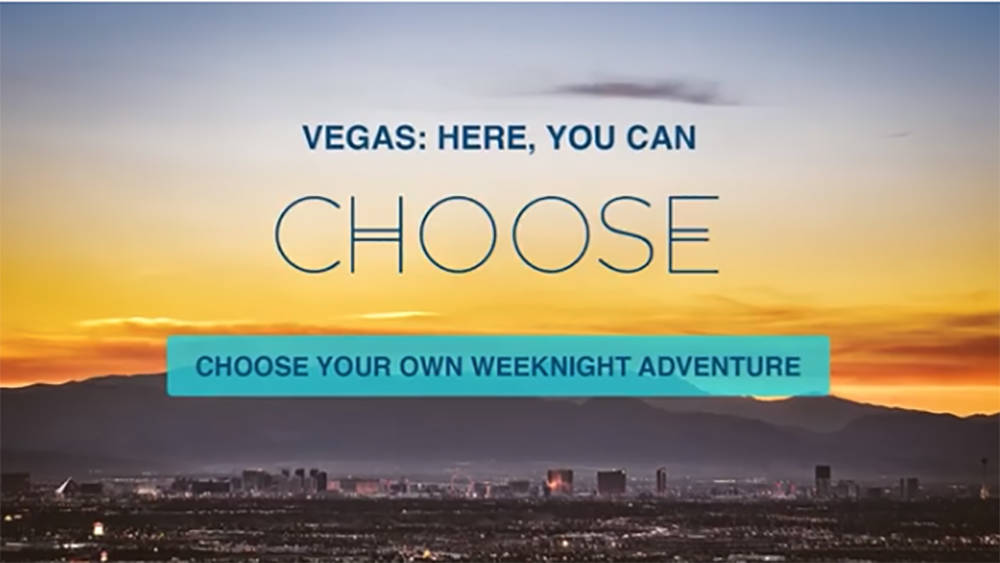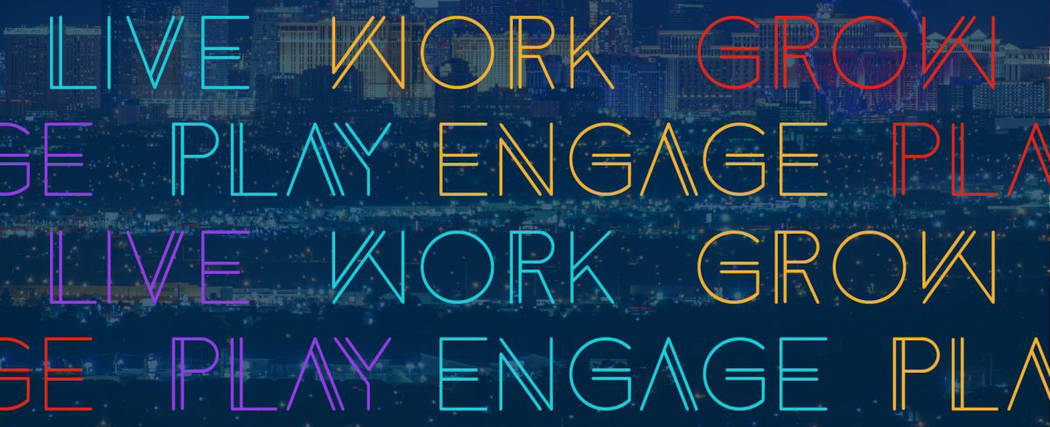“What happens here, stays here” is the international brand of Las Vegas tourism, but an economic development group has launched a campaign to get talented young professionals from California to come here to live, work and stay rather than just play and leave.
The Las Vegas Global Economic Alliance has outlined its own version of the Las Vegas Convention and Visitors Authority’s tourism ad campaign, only this time to recruit people to relocate and work in Southern Nevada in high-paying jobs, where there is a shortage of workers.
The LVGEA, Southern Nevada’s regional development authority, is testing a digital ad campaign in Los Angeles to hone its message for a wider campaign that targets other California cities in 2020. It would be the first step as part of a drive to extend the campaign to other states and deal with a shortage of workers to fill high-demand occupations as outlined by its Workforce Blueprint 2.0, released in October.
The new campaign called Here, You Can is about “promoting the exceptional quality of life we have in Southern Nevada” and overcoming some of the misperceptions and attracting talent from other markets, according to Jonas Peterson, president and CEO of the LVGEA.
“There’s a war for talent underway, and we’re competing with other markets and other states for talent to support our companies,” Peterson said. “We need to do everything we can to attract workers from other markets. We have an incredible product to sell from a business point of view. We want to do our part in selling that product and overcoming misperceptions and awareness about the incredible quality of life we have here in Southern Nevada.”
Las Vegas has long had a reputation of being the Strip, and many tourists know little about the rest of the valley outside that corridor and a thriving community and neighborhoods.
The full campaign message is: “Vegas, here you can live, work, play, grow, engage and do anything.” A campaign video has unscripted local residents touting Las Vegas as more than just the Strip and talking about restaurants, shopping, Red Rock hiking, sports and entertainment. A display ad touting Las Vegas says, “It’s LA Vibes without the 405? Take me there.”
Peterson said Las Vegas already has a strong brand in “what happens here, stays here,” but this version is for a different audience to attract people to work here. People around the world know Las Vegas and love it, which is helpful, he said, but the goal is to enhance that branding with business and quality of life messaging.
“The tourism brand of our market is really strong, and we’re trying to come alongside that and create a powerful brand for the business community about the quality of life that we enjoy in Southern Nevada and show that to the outside world — in particular talent and corporate leaders we are looking at to relocate to Southern Nevada,” Peterson said.
A “soft start” to the campaign is underway.
Breanna Bensoua, senior director of marketing and communications, said there are digital display and video ads that recently started running on social media channels in Los Angeles and are focused on young professionals.
“I think in 2020 the community and markets outside of Las Vegas will be seeing a lot more of the actual full-blown campaign delivered with new assets,” Peterson said. “What we’re doing right now is the beta testing setting up some quick ads here and there and see what’s resonating and what plays outs for the larger campaign in 2020.”
Bensoua said the goal in 2020 is to expand the campaign to the San Francisco Bay Area and San Diego and see where it goes from there. It’s primarily targeted digital advertising and paid social ads on LinkedIn, Twitter, Facebook and Instagram, she said.
Southern California is a good starting point because of the close working relationships with many businesses in Southern Nevada having connections with the state, Peterson said. Many of the companies the LVGEA works with have ties with Southern California, he added.
Clark County added more than 48,000 people between 2017 and 2018, the second-largest annual population increase of any U.S. county, and that growth remained strong this year and is expected to continue in 2020 and 2021 by an average of 2 percent, according to a UNLV report.
But Nevada is missing out on California residents who are going to other states in much greater numbers.
The U.S. Census Bureau reported in November that the top spot for Californians was Texas, which saw 86,164 Californians in 2018. Texas was followed by Arizona (68,516), Washington (55,467), Nevada (50,707) and Oregon (43,058).
Peterson said one of the obstacles to overcome in getting more of those people to come to Las Vegas is creating that awareness. He said he believes if the LVGEA message gets out, Las Vegas can attract more talented workers.
“It’s a competitive environment, and we need to do everything we can to showcase the incredible quality of life we have here in Southern Nevada,” Peterson said.
Peterson said the LVGEA is using its own marketing resources to get the campaign started. It’s also forming a council to invest in the campaign and help drive it.
“We’re putting in at least a couple of hundred thousand to start the campaign, and our intent is that it’s an ongoing effort,” Peterson said. “We’re looking to build it significantly with in-kind investments.”
While the campaign starts in California, Peterson said the next steps depend on how the campaign is going and what the leadership group wants.
Software developer for apps has risen to the No. 1 in-demand job in Southern Nevada as part of the updated plan outlining high-demand occupations in the region. The Workforce Blueprint 2.0, which is a forecast of annual job openings and gaps in filling them, serves as a road map for workforce development, but business leaders recognize that not all of the in-demand positions can be filled by growing an educated workforce locally.
The list has operations managers second, followed by all other managers within a company. Registered nurses were ranked fourth and business operations specialists fifth on the 2019 report. They are followed by civil engineers, finance managers, aircraft mechanics and service technicians, respiratory therapists and electrical engineering technicians.
Computer systems analysts, network and computer systems administrators, accountants/auditors and licensed practical and vocational nurses fell out of the top 10.
The business headquarters and services sector is projected to see its jobs grow by 36 percent by 2026 or by more than 47,000 between 2016 and 2026. Emerging technology will grow by 29 percent or 2,681 jobs; logistics, manufacturing and supply-chain management by 33 percent, or 2,681 jobs; autonomous systems by 36 percent, or 1,854 jobs; finance, insurance and banking by 17 percent, or 4,432 jobs; health care services by 27 percent, or 19,561 jobs; and gaming, tourism and conventions by 18 percent, or 50,878 jobs, bringing the total to 336,043 by 2026.
Since the recession, Nevada has seen new employers from Tesla, Amazon, Google and others as it remains attractive because of its business-friendly and tax-friendly environment.
Not only are there openings for existing companies, but one of the issues Las Vegas has faced over the years in attracting companies to locate here is the lack of a skilled workforce to fill those jobs.
The gaps are in part because strong economic growth, Peterson said. While it’s a good problem to have, but more talent is needed, he said.
The first goal is to fill as many jobs as possible locally with existing workers and by training Southern Nevada residents, Peterson said. That is desired, but “there are limits there,” and they need to reach out to other states for workers to be competitive with other markets. It takes more than good high-paying jobs, however, to attract people, he added.
“We know through the Blueprint that we have a lot of in-demand occupations where we have existing and projected gaps,” Peterson said. “That means we need to strengthen our education system to turnout more of our homegrown talent. But as long as we have those gaps, we need to attract people from other markets to fill those occupation needs. That is part of what the Here, You Can campaign is designed to do. Those professional occupations are very much a target for us.”
For more information on the campaign, visit www.lvgea.org.









